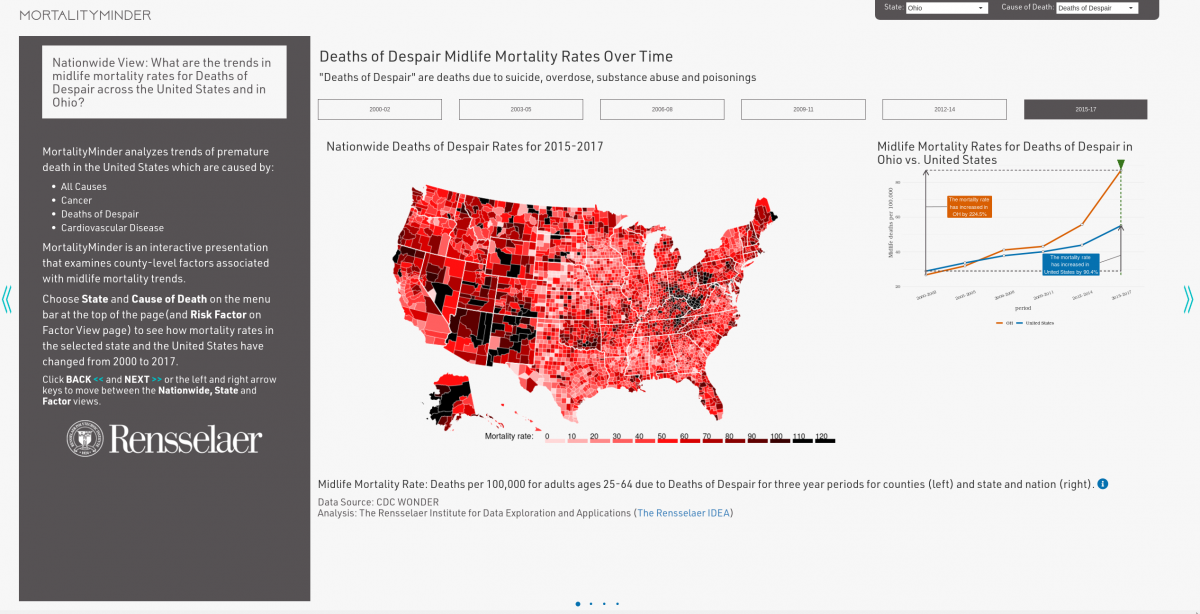
MORTALITYMINDER Live App | MORTALITYMINDER Overview Video | MORTALITYMINDER GitHub
WE WON! MORTALITYMINDER won third place in the Visualization of Community-Level Social Determinants of Health Challenge, run by the US Dept. of Health and Human Services (HHS) Agency for Healthcare Research and Quality (AHRQ).
ABOUT MORTALITYMINDER
The goal of MortalityMinder (MM) is to enable healthcare researchers, providers, payers, and policy makers to gain actionable insights into how, where, and why midlife mortality rates are rising in the United States (US).
- Explores mortality trends for midlife adults ages 25-64 across the United States from 2000 to 2017 using data from CDC WONDER, the definitive source of US mortality data.
- Identifies social and economic factors associated with increased mortality trends at the county-level for each state and the nation obtained from County Health Rankings (CHR), an aggregate of county-level data from 20 sources curated by the Robert Wood Johnson Foundation.
- Addresses factors including health behaviors, clinical care, education, employment, social supports, community safety and physical environment domains.
- Interactively visualizes potential determinants and their impact on mortality trends.
- Investigates deaths due to All Causes, Cancer Deaths, Cardiovascular Deaths, Deaths of Despair (suicide, self harm and overdose).
- Publicly-accessible, freely available, easily maintained, and readily extensible open source web tool.
Limitation: Associated factors are correlated to midlife mortality rates. Further investigation is needed to see if they actually cause changes in mortality rate.
INNOVATION
MortalityMinder (MM) dramatically illustrates midlife mortality rate increases reported in (Wolf and Schoomaker, JAMA 2019), while providing greater insight into community-level variations and their associated factors to help determine remedies.
Using authoritative data from the CDC and other sources, MM is designed to help health policy decision makers in the public and private sectors identify and address unmet healthcare needs, healthcare costs, and healthcare utilization.
Innovative analysis divides counties into risk groups for visualization and correlation analysis using K-Means clustering and Kendall correlation.
For each State and Cause of Death, MM dynamically creates three analysis and visualization infographics:
- National View reveals midlife mortality rates through time and compares state and national trends.
- State View categorizes counties into risk groups based on their midlife mortality rates over time. The app determines correlations of factors to risk groups and visualizes the most significant protective and destructive factors.
- Factor View enables users to explore individual factors including their relation to the selected cause at a county level for each state and the distribution of those factors within each state.
- Selecting 'United States' for State initiates nationwide analysis.
INSIGHTS
MortalityMinder provides a compelling and engaging tool to investigate the social and economic determinants of mortality. MM:
- Documents the disturbing rise in midlife Deaths of Despair due to suicide, overdose, and self-harm and other national/regional increases in midlife mortality rates due to All Causes, Cancer, and Cardiovascular Disease.
- Highlights potential social determinants through statistical analysis of factors associated with disparities in regional trends in midlife mortality rates.
- Provides county-level confirmation of trends and hypothesized causes.
- Yields insights that can be used to create region-specific interventions and best practices to meet unmet healthcare needs.
- Enables rigorous analysis of potential determinants of health by local, state, and national healthcare organizations to support development of programs, policies, and procedures to improve longevity.
IMPLEMENTATION AND DEPLOYMENT
MortalityMinder is an open-source R project freely available with full documentation via a GitHub repository.
- R was chosen for its powerful environment for statistical computing and graphics using standard packages.
- MM utilizes the R Shiny and FullPage Javascript frameworks for web interactivity.
- Source data preparation is documented on the GitHub Wiki. Data Loader scripts enable new data sources and preparations to be easily incorporated. Data may be downloaded under 'DOWNLOAD SOURCE DATA'.
- Missing county mortality rates are imputed using state-wide rates and Amelia R Package.
- MM can be run from the public web locations or installed locally.
- Code is easily customized, extended, and maintained. The app continuously evolves in an agile framework to incorporate user feedback and introductions of new data streams, analyses, visualization, and health care problems.
- App design based on formal usability study of 20+ users and recommendations from our advisory board of healthcare and design professionals.
- The innovative visualizations and analytics in MortalityMinder can be adapted into other applications or formats by using the provided code and data.
ACKNOWLEDGEMENTS
MortalityMinder was created by undergraduate and graduate students in the Health Analytics Challenge Lab at Rensselaer Polytechnic Institute with generous support from the United Health Foundation and the Rensselaer Institute for Data Exploration and Applications (IDEA). MortalityMinder was directed by Kristin P. Bennett and John S. Erickson.
The MortalityMinder Team would like to thank our advisory board, including Ms. Anne Yau, United Health Foundation; Dr. Dan Fabius, Continuum Health; Ms. Melissa Kamal, New York State Department of Health; and Dr. Tom White, Capital District Physicians' Health Plan (CDPHP).
Please send questions and comments about MortalityMinder to: erickj4@rpi.edu
Suggest improvements and report bugs on GitHub
- HHS AHRQ COMPETITION RESULTS
- US Dept. of Health and Human Services (HHS) Agency for Healthcare Research and Quality (AHRQ), "Visualization of Community-Level Social Determinants of Health Challenge." See https://www.ahrq.gov/challenges/past/sdoh/index.html
- MORTALITYMINDER PUBLICATIONS
- Bhanot, K., Erickson, J.S., and Bennett, K.P. 2024. "MortalityMinder: Visualization and AI Interpretations of Social Determinants of Premature Mortality in the United States." Information 15, 254. http://dx.doi.org/10.3390/info15050254
- Karan Bhanot, Jocelyn McConnon, Skye Jacobson, Lilian Ngweta, John S. Erickson, and Kristin P. Bennett, "Investigating Social Determinants of Premature Mortality in the United States." 2023. https://idea.rpi.edu/media/45
- LINKS
